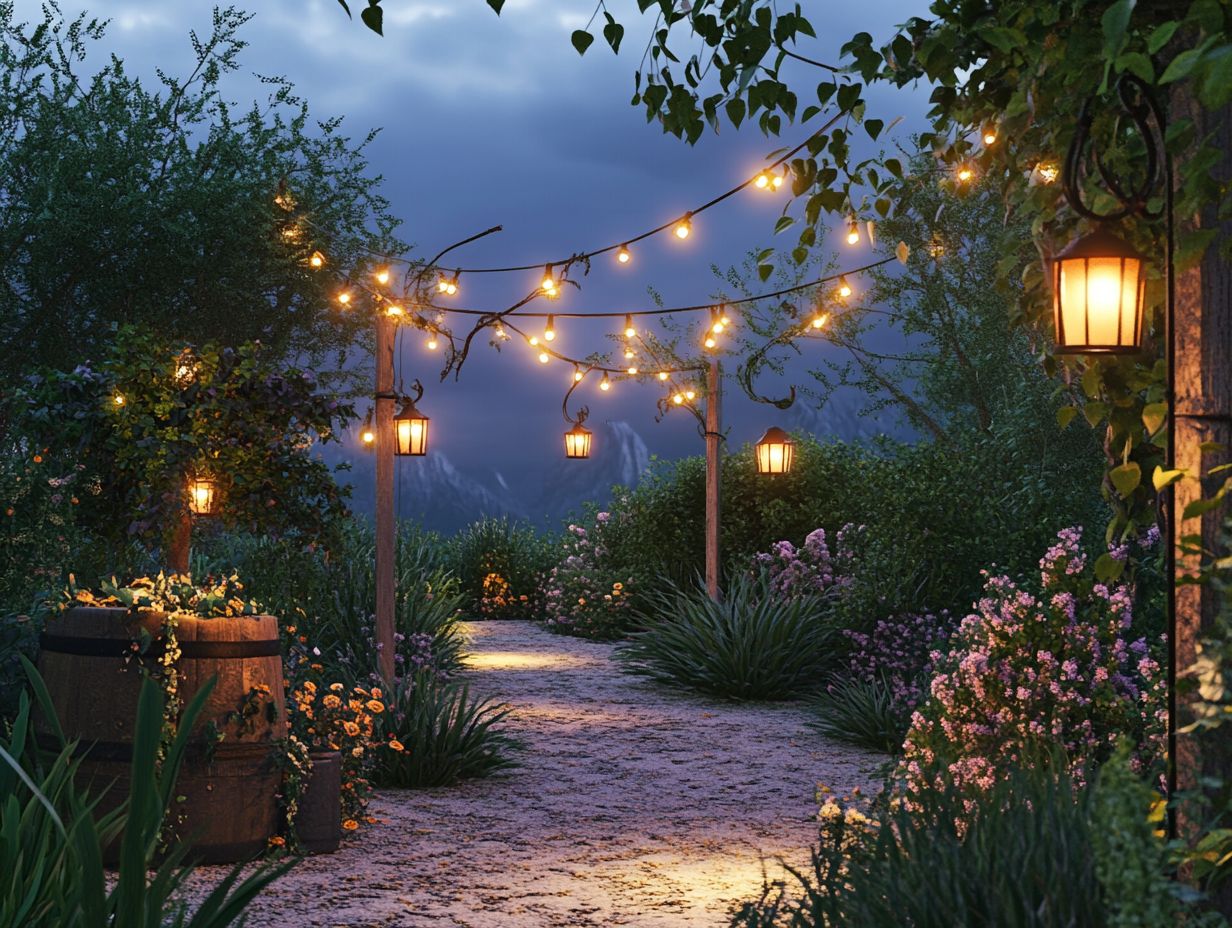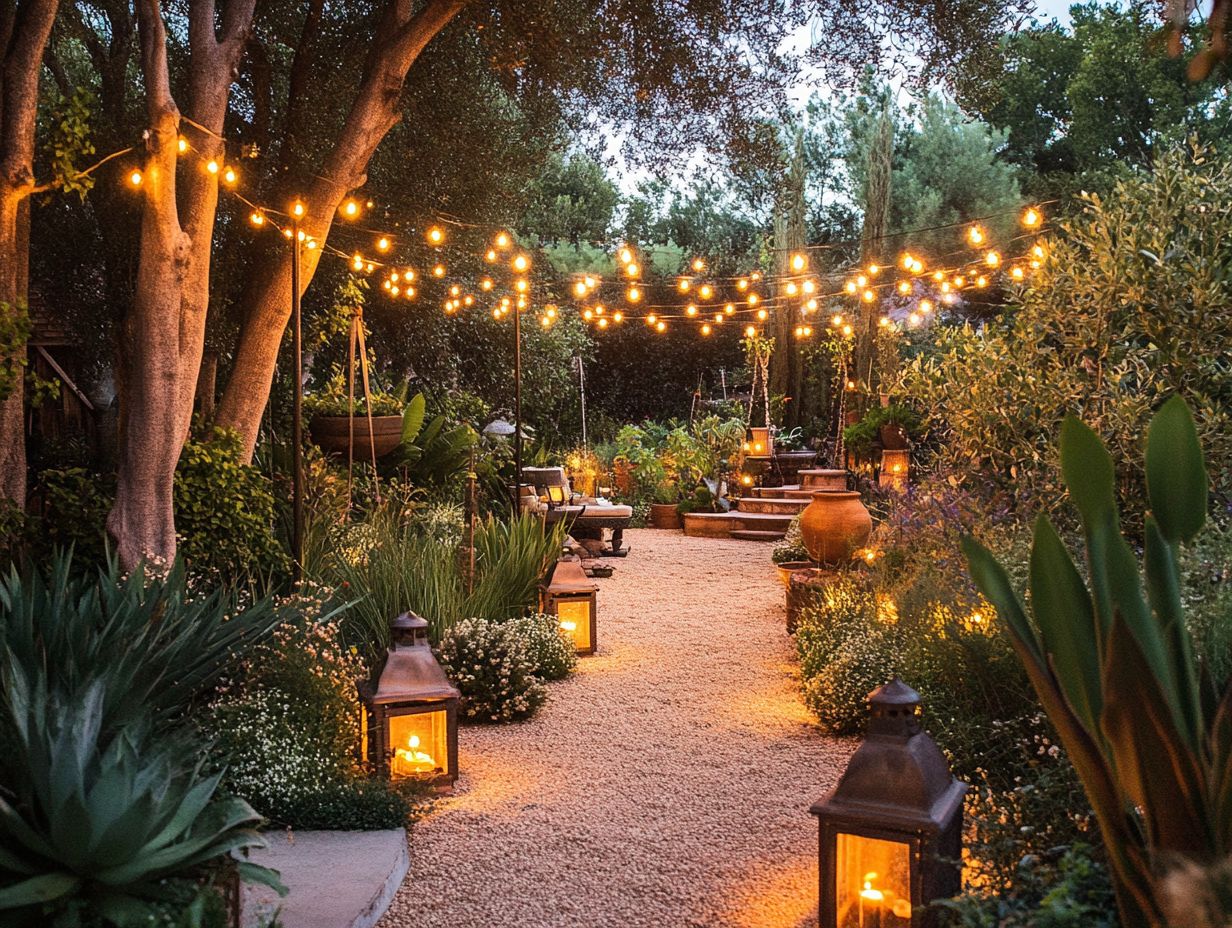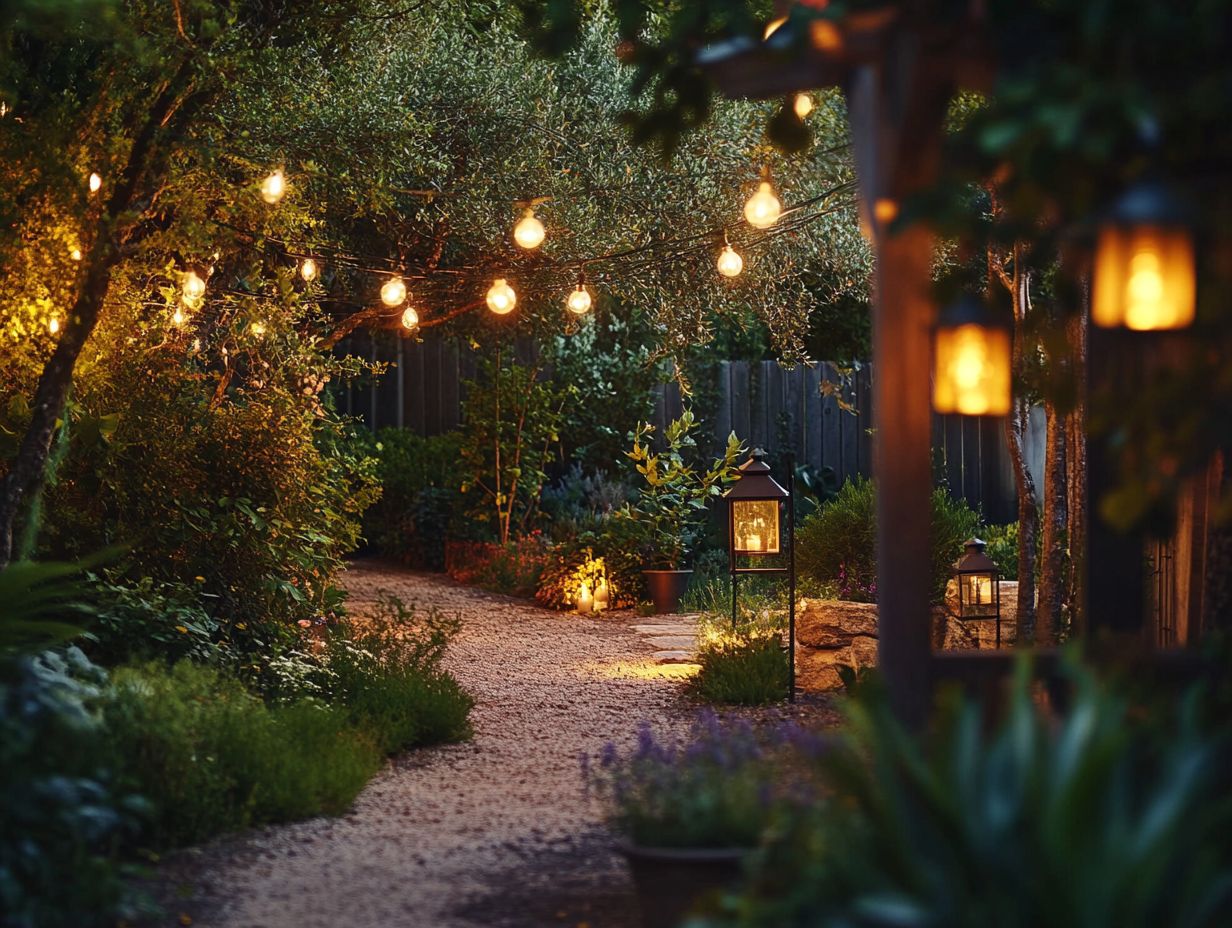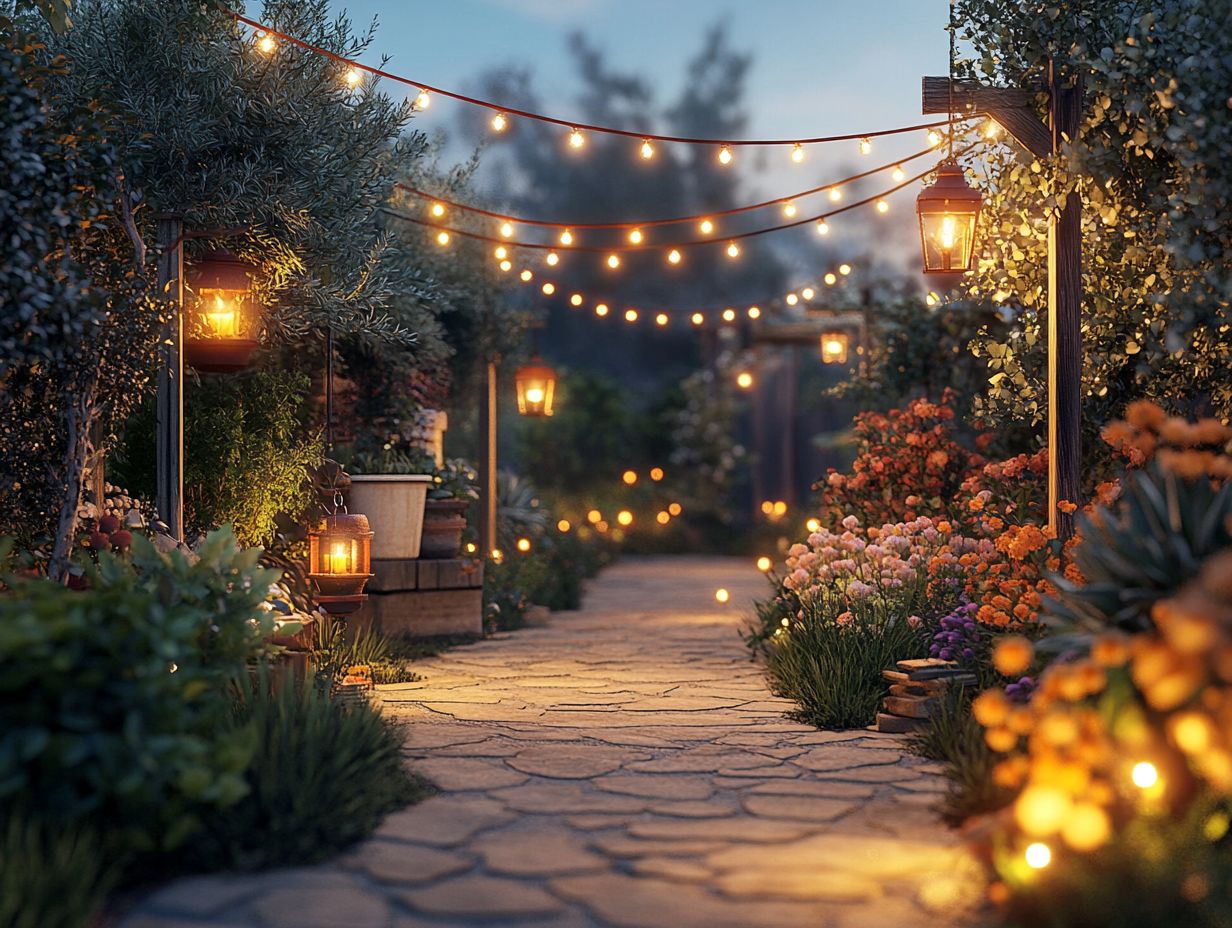Transforming an outdoor space with appropriate landscape lighting can significantly enhance the ambiance while improving safety and security.
This article examines the importance of proper lighting and provides guidance on various types of fixtures, including spotlights, path lights, and string lights.
It also highlights essential factors to consider when selecting the ideal fixtures, offers tips for installation and maintenance, and provides budgeting insights to achieve optimal results.
By utilizing effective and stylish lighting solutions, one can significantly enhance the overall landscape.
Understanding Landscape Lighting

Understanding landscape lighting is essential for enhancing the beauty, functionality, and safety of outdoor spaces. Thoughtfully designed outdoor lighting not only highlights architectural features but also contributes to the overall ambiance of the landscape.
With a variety of lighting styles available, homeowners can select from both decorative and functional options that align with their preferences while ensuring energy efficiency. By taking into account factors such as lighting placement, fixture materials, and local regulations, individuals can create a visually appealing and safe environment that complements natural elements like flora and fauna.
Importance of Proper Lighting
Proper lighting is essential for establishing a safe and welcoming outdoor environment, particularly during nighttime hours when visibility may be compromised.
Plus illuminating pathways and entrances, well-considered outdoor lighting plays a vital role in preventing accidents and detering unwelcome visitors. By ensuring that areas are adequately lit, individuals can navigate safely while maintaining peace of mind.
The strategic placement of ambient and accent lighting can significantly enhance the visual appeal of outdoor spaces, creating a pleasing atmosphere that encourages social interactions. This combination of safety and aesthetics not only protects against potential hazards but also fosters an inviting mood, making evenings spent outdoors more enjoyable for all.
Types of Lighting Fixtures
Numerous types of lighting fixtures are available for landscape lighting, each specifically designed to serve distinct purposes and enhance the visual appeal of outdoor environments.
From LED lights that promote energy efficiency to solar lights that provide eco-friendly alternatives, homeowners are presented with a diverse array of options tailored to their individual preferences and requirements.
A thorough understanding of the various types of outdoor lighting, including flood lights, wall sconces, and path lighting, is essential when designing an outdoor space that effectively balances functionality with aesthetic considerations.
Spotlights
Spotlights are highly effective lighting fixtures designed to focus on specific areas or features, thereby enhancing the aesthetic appeal of architectural elements or garden features.
They are available in various types, including LED, halogen, and incandescent, each offering distinct brightness levels that can be adjusted to achieve the desired ambiance. For instance, LED spotlights are known for their energy efficiency and provide a bright, crisp light, whereas halogen lights emit a warmer glow that contributes to a cozy atmosphere in outdoor spaces.
The color temperature of the spotlight is instrumental in establishing mood; cooler tones tend to accentuate contemporary designs, while warmer hues are well-suited for traditional landscapes.
Successful installation necessitates careful consideration of positioning to minimize glare and maximize visibility. Placing spotlights at low angles can effectively highlight textures and details, resulting in a visually stunning landscape during the nighttime hours.
Path Lights

Path lights fulfill a dual function of illuminating walkways and enhancing safety by clearly delineating paths in outdoor environments.
These fixtures not only facilitate safe navigation for visitors during nighttime but also contribute aesthetically to gardens and yards. A variety of styles of path lights are available, ranging from traditional lantern designs to sleek, modern fixtures that seamlessly connect with contemporary landscapes.
They can operate with different wattages and voltages, enabling homeowners to select options that align with their energy efficiency objectives while ensuring adequate brightness for visibility. Understanding light distribution is essential; strategically placed path lights can effectively illuminate pathways without causing harsh glares, thus creating a warm and inviting atmosphere while preserving the integrity of the landscape.
String Lights
String lights have become an increasingly popular choice for creating a warm and inviting outdoor ambiance, particularly during social gatherings and events.
They effectively transform patios, gardens, and balconies into enchanting spaces, ideal for evening functions. With options for straightforward installation, such as hook-and-loop straps or adhesive clips, they cater to both DIY enthusiasts and individuals seeking a hassle-free setup.
Whether illuminating an intimate dinner with friends or adding a festive touch to seasonal celebrations, these lights enhance the overall mood while being energy-efficient. As seasons change, adjustable brightness settings facilitate the maintenance of the ideal atmosphere, allowing for flexible use throughout the year without significant increases in energy consumption.
Floodlights
Flood lights play a crucial role in outdoor security lighting by providing broad illumination that enhances visibility and deters potential intruders.
These powerful fixtures are essential not only for the protection of residential areas but also for various commercial applications, including event lighting for gatherings and outdoor installations. With their exceptional brightness and impressive light output, flood lights effectively illuminate driveways, parking lots, and building exteriors, thereby ensuring a well-lit environment that complies with safety codes and local regulations.
It is imperative for property owners to familiarize themselves with the relevant guidelines, as improper installation may result in safety hazards and legal repercussions. When utilized effectively, flood lights can create a secure and welcoming atmosphere for both residential and commercial properties.
Factors to Consider When Choosing Fixtures
When selecting lighting fixtures for landscape design, several essential factors must be meticulously considered to achieve both aesthetic appeal and functionality. The choice of fixtures should align with the overall design principles of the outdoor space, ensuring that they complement natural elements and architectural features.
Important considerations include lighting placement, durability, and energy efficiency, in addition to the homeowner’s budget. These elements are crucial for developing a cohesive and effective lighting strategy.
Design and Aesthetic

The design and aesthetic of lighting fixtures play a crucial role in shaping the overall appearance and character of outdoor spaces. These fixtures not only illuminate pathways, gardens, and architectural features but also significantly influence visual harmony through the selection of materials such as brushed metal, glass, or natural stone.
When thoughtfully chosen, these elements collaboratively create an inviting atmosphere that directs attention and emphasizes focal points. Incorporating a variety of lighting styles—ranging from subtle sconces to vibrant accent lights—contributes to a cohesive design that promotes balance and visual hierarchy. This deliberate approach to lighting allows outdoor areas to flourish at night, transforming them into welcoming destinations.
Functionality and Practicality
Functionality and practicality are essential factors to consider when selecting lighting fixtures for outdoor environments, ensuring that they effectively fulfill their intended purposes.
The appropriate fixtures enhance safety, security, and aesthetics, contributing to the creation of inviting outdoor spaces suitable for gatherings or for enjoying a peaceful evening. Energy efficiency is a significant consideration in this selection process, as it not only reduces electricity expenses but also minimizes environmental impact.
Understanding light color temperature is crucial, as it can greatly influence the ambiance and usability of outdoor areas, with warmer tones often fostering a cozy atmosphere. Maintenance requirements should also be considered, as durable fixtures that are easy to maintain provide long-term value.
Ultimately, selecting cost-effective yet functional lighting solutions can transform outdoor environments while maintaining a balance between efficiency and upkeep.
Installation and Maintenance
The installation and maintenance of outdoor lighting fixtures are crucial for ensuring their longevity and effectiveness in enhancing landscape design.
DIY vs Professional Installation
The choice between DIY lighting installation and engaging professional landscapers can significantly influence both the outcome and efficiency of the project.
This decision is often contingent upon several factors, including the skill level of the individual undertaking the task and the budget allocated for such enhancements. On one hand, DIY installation offers creative freedom and potential cost savings, appealing to those with hands-on expertise. However, this approach carries inherent risks if the installer lacks experience, particularly in adhering to safety codes that govern electrical wiring and outdoor setups.
Conversely, while professional installation services may entail a higher upfront cost, they provide reassurance through expert knowledge and guarantees that all work will comply with necessary safety standards. This ensures that the project is completed efficiently and effectively.
Proper Maintenance Techniques

Proper maintenance techniques are essential for extending the lifespan of lighting fixtures and ensuring optimal performance throughout the seasons.
Regular cleaning of lighting fixtures not only enhances their aesthetic appeal but also reduces energy consumption, as the accumulation of dust and grime can diminish brightness. Seasonal adjustments are equally important; for instance, transitioning to warmer tones during the winter months can create a cozy atmosphere while maximizing efficiency.
Routine inspections should be conducted to facilitate the early identification of potential issues that could impact durability. Additionally, understanding product warranties can inform maintenance strategies, ensuring that any necessary replacements or repairs are covered, thereby contributing to long-term satisfaction and reliability.
Budgeting for Lighting Fixtures
Budgeting for lighting fixtures requires a thorough evaluation of both initial costs and the long-term savings that can be realized through energy efficiency and durability.
Cost of Fixtures and Installation
The costs associated with fixtures and installation can vary considerably, influenced by factors such as fixture materials, complexity of the installation, and individual homeowner preferences.
For instance, selecting energy-efficient lighting solutions may involve higher initial costs; however, this choice can lead to significant savings on electricity bills over time. Homeowners should also evaluate the type of fixtures they prefer—whether LED, fluorescent, or incandescent—since each option presents its own pricing structure and lifespan.
Moreover, installation services can contribute to the overall expenditure, particularly in cases where extensive electrical work is necessary.
By carefully assessing these factors and considering budgetary implications, individuals can make informed decisions that effectively balance aesthetic appeal with long-term energy consumption savings.
Long-term Savings and Benefits
Investing in high-quality lighting fixtures can yield substantial long-term savings, particularly through the adoption of energy-efficient options such as LED lights.
Transitioning to these modern illumination solutions enables significant reductions in monthly utility costs while providing the added benefit of minimal maintenance requirements. The affordability of energy-efficient lighting positions it as an appealing choice for both households and businesses, allowing for greater allocation of funds towards other essential expenses.
Moreover, these lighting options contribute to a reduced carbon footprint, thereby promoting a healthier environment. The extended lifespan of these fixtures results in fewer replacements, further enhancing their cost-effectiveness.
By selecting energy-efficient lighting, individuals actively engage in a sustainable lifestyle that benefits both their financial well-being and the health of the planet.